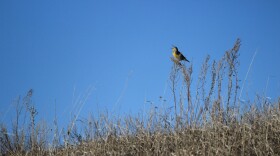One of the common signs of spring is when we look up at the trees and see something different up there. The trees must be leafing out! Spring is officially here! But much of what we see up there is more likely flowers.
We typically think of flowers as colorful and fragrant structures, but that is to attract pollinators, for example bees and butterflies. But many plants are wind pollinated, and showy, aromatic flowers are not needed to attract the wind. Grasses produce wind pollinated flowers. And it might surprise you, but most of the deciduous trees, green ash, bur oak, cottonwood, and quaking aspen, to name a few, are wind pollinated. Like the grasses, the flowers of the trees with wind pollinated flowers are rather drab, small, and inconspicuous. We will easily see the fruits of these trees, such as the acorns from oaks and samaras from ash and maple. But one must take a closer look at the trees this time of year to observe the flowers.
The wind pollinated flowers of these trees will be produced before the leaves are fully leafed out. If the tree leafed out first, the leaves would block the wind and fewer flowers would be pollinated. Because many of these flowers are produced high up in the tree on young twigs, we often assume the tree is budding out. That generally comes a bit later.
You might be surprised to learn that many of our deciduous trees are either male trees or female trees. So, a plant will either produce male or female flowers, not both. Examples are green ash, willow, aspen, and cottonwood. You’ve probably noticed that some cottonwoods always produce cotton while others never do. Only female trees produce cotton. That’s their seeds being dispersed.
The male flowers of green ash, for example, consist of tight dark ball or cluster of stamens near the end of twigs before the leaves leaf out. They start out yellowish green to greenish purple before eventually turning a gray-brown. The female flowers are also produced near the end of twigs but are produced in small loose clusters.
So, make a point to look closer at the deciduous trees this spring and see if you can discover the flowers.




